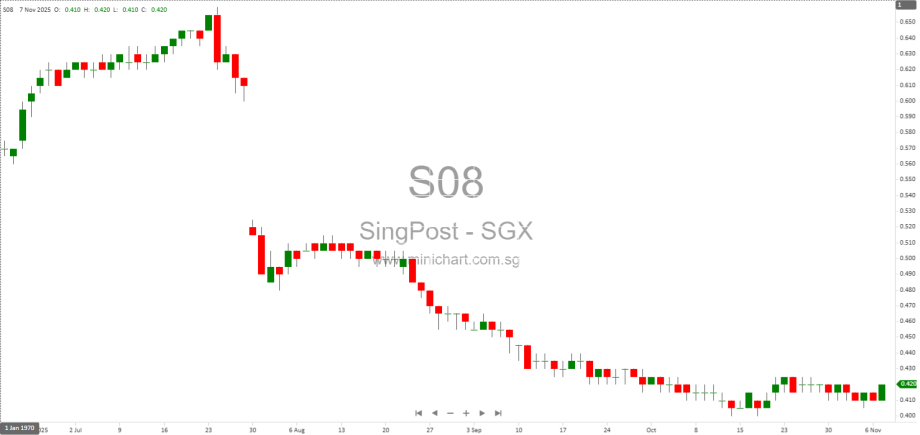Singapore Post Ltd H1 FY2025/26 Financial Analysis: Restructuring for Stability and Future Growth
Singapore Post Ltd (“SingPost”) has released its H1 FY2025/26 results, reflecting a period of substantial corporate restructuring and operational refocusing following major divestments. This article analyzes the key financial metrics, segmental performance, and strategic actions, providing insight for investors evaluating their position in SingPost.
Key Financial Metrics and Performance
| Metric | H1 FY25/26 | H2 FY24/25 | H1 FY24/25 | YoY Change | QoQ Change |
|---|---|---|---|---|---|
| Group Revenue (S\$ million) | 188.4 | Not disclosed | 259.6 | -27.4% | N/A |
| Operating Profit (S\$ million) | 5.7 | (Loss reported) | 16.8 | -66.0% | Positive vs previous half |
| Net Profit Attributable to Equity Holders (S\$ million) | 19.7 | Not disclosed | 22.6 | -12.8% | N/A |
| Underlying Net Profit (S\$ million, ex-exceptionals) | 5.5 | Not disclosed | 25.2 | -78.0% | N/A |
| Interim Dividend (cents per share) | 0.08 | Special dividend paid (S\$202.6m) | Not disclosed | N/A | N/A |
SingPost’s H1 FY25/26 results were marked by a sharp decline in revenue and underlying net profit, largely attributed to the divestment of major subsidiaries (notably the Australia business, 4PX, and Quantium Solutions JV) and a significant drop in cross-border eCommerce volumes. The company’s operating profit was supported by exceptional gains from asset disposals and fair value adjustments.
Segmental Performance
- Logistics & Letters: Revenue fell by 33.1% YoY to S\$153.5 million, with operating profit swinging to a loss of S\$4.4 million due to adverse market conditions and a 63% YoY decline in cross-border eCommerce volumes. Letter mail volume continued its structural decline.
- Post Office Network: Revenue decreased by 13.9% YoY, but operating losses narrowed as cost reductions followed the consolidation and streamlining of post offices (network reduced from 46 to 40).
- Property Assets: Provided stable contributions, with revenue up 3.4% YoY to S\$40.6 million. Operating profit dipped slightly, mainly due to higher expenses, but SingPost Centre maintained a high occupancy rate of 99.2%.
Balance Sheet and Cashflow
- Cash Position: S\$594.1 million as at 30 September 2025, down from prior period due to the payout of a special dividend and divestments.
- Equity: Total equity decreased, reflecting lower retained earnings post-dividend and elimination of non-controlling interests after divestments.
- Cashflows: Operating cash flow before working capital changes dropped sharply due to absence of contributions from divested businesses. Net cash decreased by S\$98 million in the half, primarily driven by the special dividend payout.
Corporate Actions and Exceptional Items
- Major Divestments: Completed sales of the Australia business, 4PX, the Famous Holdings group, and ongoing divestment of Quantium Solutions regional subsidiaries.
- Exceptional Gains: S\$13.9 million in exceptional items, mainly from asset disposals and a fair value gain on SingPost Centre.
- Dividend Policy: Interim dividend of 0.08 cents/share, in line with a 30-50% payout range of underlying net profit. A special dividend of S\$202.6 million was paid out earlier in the year.
Operational and Strategic Developments
- Investment in eCommerce Infrastructure: S\$30 million allocated for expanding small-parcel sorting capacity, with completion expected by mid-2026.
- Network Optimization: Strategic consolidation of post offices and push towards partnerships for scalability and agility.
- Balance Sheet Strength: Despite reduced equity, SingPost maintains strong cash reserves, providing flexibility for future investments and growth.
Historical Performance Trends
SingPost has undergone a significant pivot away from international and cross-border logistics, focusing on a leaner, more Singapore-centric business. This transition, while necessary for long-term sustainability, has resulted in lower revenues and profits in the short term, with normalized operating metrics expected once the restructuring stabilizes.






